#Genus: Toxomerus
Explore tagged Tumblr posts
Text


Range: much of North America
#poll#Class: Insecta#Order: Diptera#Family: Syrphidae#Genus: Toxomerus#Toxomerus Marginatus#Range: Nearctic#Range: Neotropical#bug tw#insect tw
38 notes
·
View notes
Text
I see at least one cool bug a day, and usually many more, but it’s not because I live anywhere particularly rich in strange, wonderful creatures (I live in an unremarkable corner of Pennsylvania, USA) or spend all of my free time looking for bugs (well, just *most* of it). in my experience, finding interesting bugs is less about actually locating them and more about looking closely at tiny things you’d otherwise ignore!
this very long post was compiled over a couple days in late July, although I spent less than 10 minutes at a time searching. there’s a lot of fun creatures just out in the open.
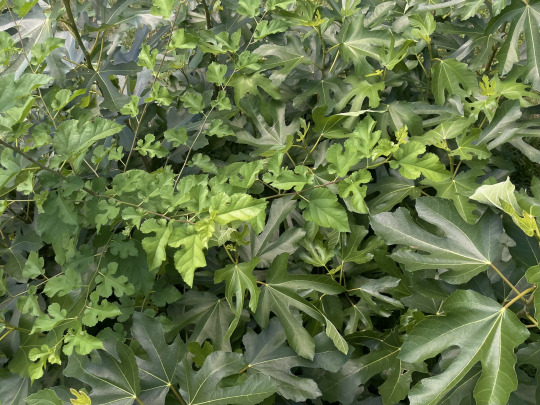
plants are always a good place to start when looking for bugs, and I chose this small fig tree (Ficus carica) with a mulberry sapling friend. feeding on the sap of the fig and mulberry is the first group I’ll take a look at, the planthoppers:

these two are flatid bugs, Metcalfa pruinosa and Flatormenis proxima. flatids are slow-moving bugs that can be approached closely, but once they get tired of circling around stems to avoid you they may launch themselves into a fluttering flight with spring-loaded rear legs.
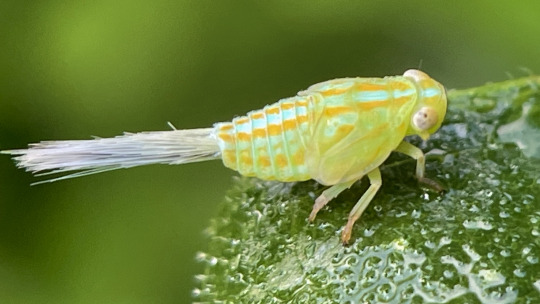
Aplos simplex, a member of the related family Issidae, also likes fig sap. its “tail” is actually a tuft of waxy secretions, which get shed along with the bright colors when it assumes a lumpy, bean-shaped adult form.
cicadellids, or leafhoppers, are just about everywhere on plants, but can be hard to approach without scaring them.
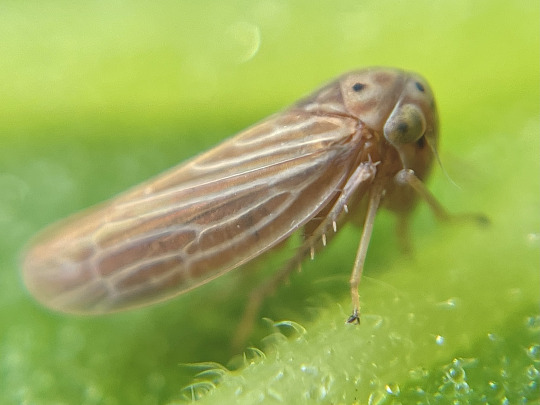
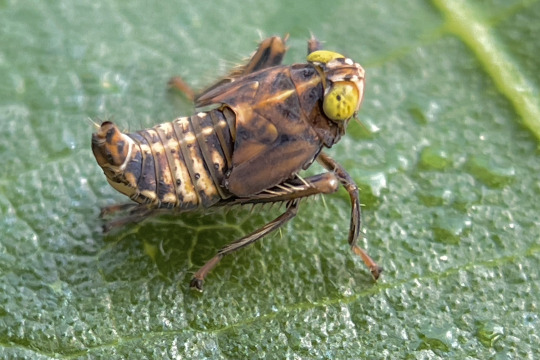
Agallia constricta on the left is a tiny species that feeds on grass, but many were scared up onto the fig by my footsteps. Jikradia olitoria is a much larger species that does feed on the fig; juveniles like this are curled, creeping goblins while adults’ rounded wings give them a pill-shaped appearance.

this big, pale leafhopper belongs to genus Gyponana. it’s tricky to get to species ID with these.
Graphocephala are striking little hoppers that eat a variety of native and nonnative plants. G. coccinea is the larger, more boldly colored one and G. versuta is smaller but more common locally. they’ll sit on the tops of leaves but take flight if you get too close quickly.

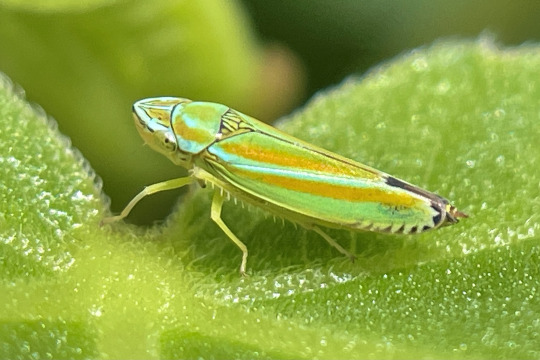
another group you’re almost guaranteed to encounter are flies (Diptera). these are a very diverse group, so much more than houseflies and mosquitoes (though I did run into both)
where I live, any plant with broad leaves is almost guaranteed to have a few Condylostylus, long-legged flies that come in shades of blue, green, and red. despite their dainty physique, they’re agile predators, typically feeding on other small flies.
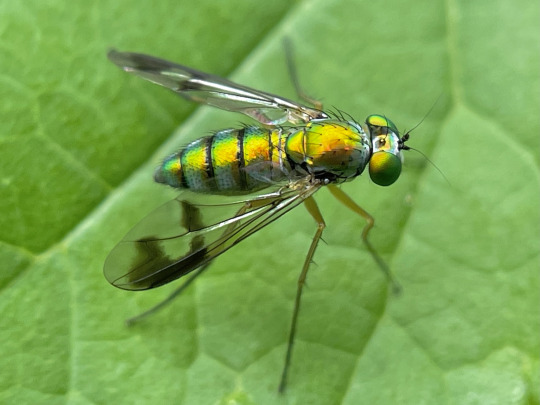
next, a few hoverflies: the ubiquitous Toxomerus geminatus and a Eumerus that I’ve been seeing a lot of this year (but maybe I’ve just noticed them for the first time). syrphids have varied life histories, but most adults drink nectar and many of the larvae are predaceous on aphids.
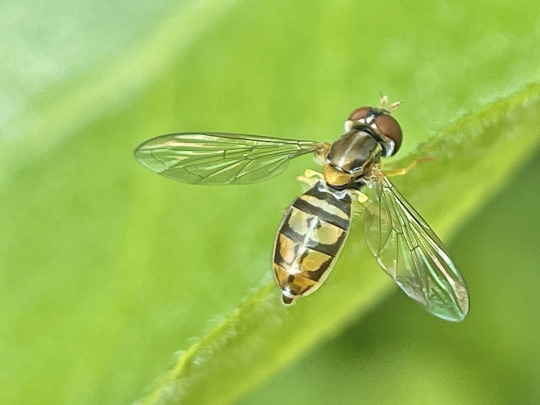
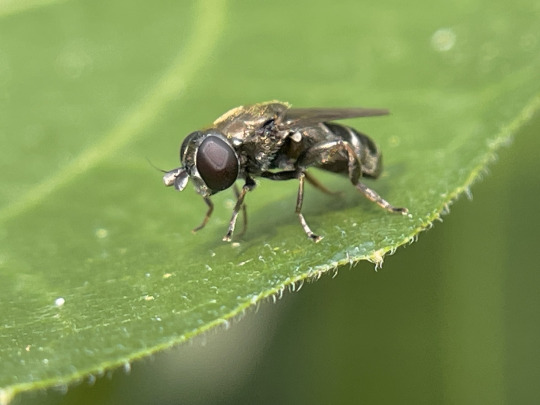
the metallic green soldier fly is Microchrysa flaviventris, nonnative here. Coenosia is a fun example of a “fly that looks like a fly,” with big red eyes and a gray body, and you might think they’re just another dung-sucking pest, but they’re actually aggressive predators! this one seemed to have nabbed itself some sort of nematoceran fly, maybe a fungus gnat.
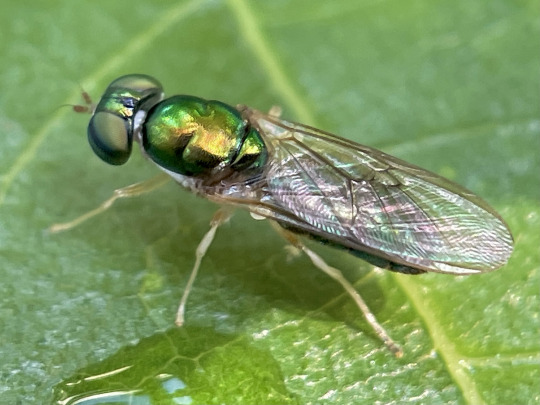
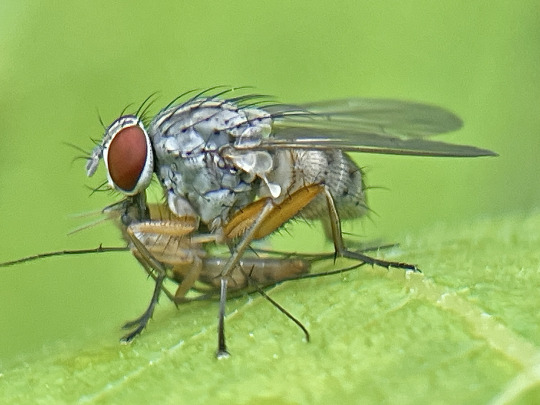
many flies are very tiny, just millimeters long. the first two little fellows are lauxaniids, while the last one, an agromyzid leafminer Cerodontha dorsalis, burrows through grass leaves as a larva.
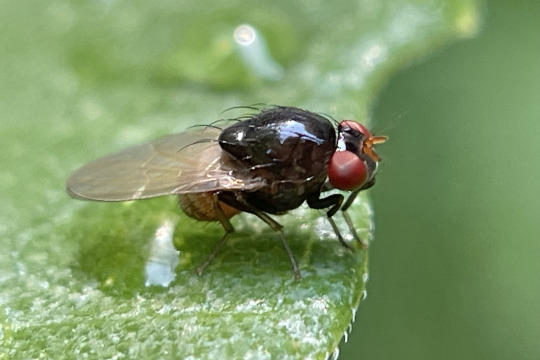
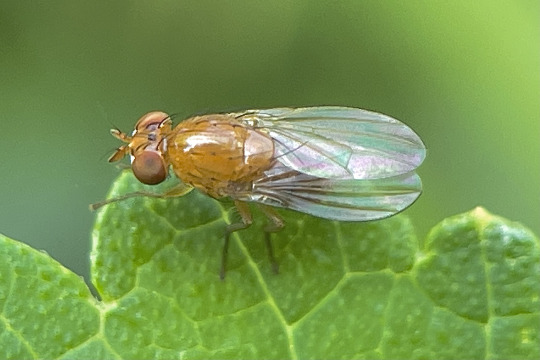
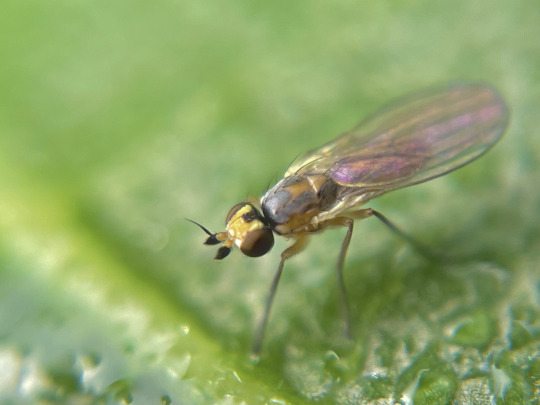
while moths and butterflies (Lepidoptera) are drawn to plants for their flowers or to lay eggs, many small moths can easily be found resting on or under leaves during the day.
these first two are tortricids, many of which are flat, rectangular moths resembling chips of bark or dead leaves. the apple bud moth, Platynota idaeusalis, feeds on a wide variety of hosts, while this beat-up old Argyrotaenia pinatubana would have developed in an edible tube nest of pine needles.

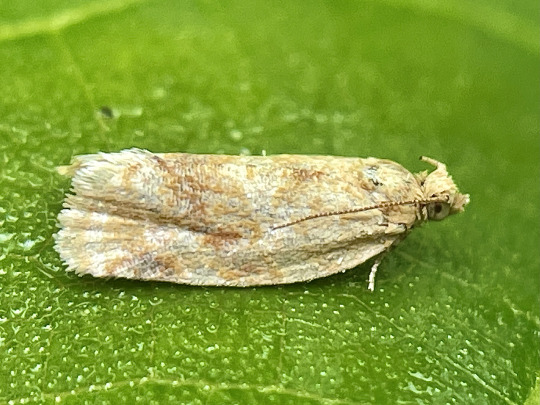
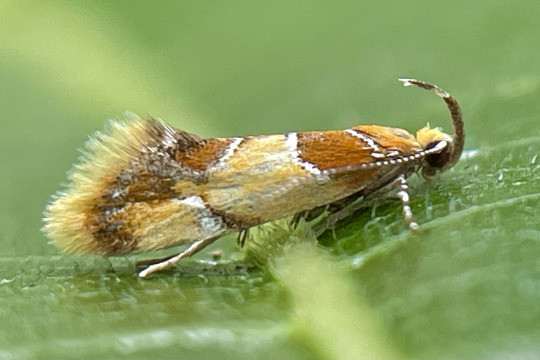

Callima argenticinctella feeds in bark and dead wood (a resource used by more caterpillars than you’d realize!) while the last moth, possibly an Aspilanta, is a leafminer.
although beetles (Coleoptera) are famous for their diversity, I didn’t find too many on the fig. the invasive Oriental beetle Exomala orientalis resting here can be found in a wide range of colors, from this common tan to to deep iridescent black. the other beetle is a Photinus pyralis firefly, sleeping under leaves as fireflies do.
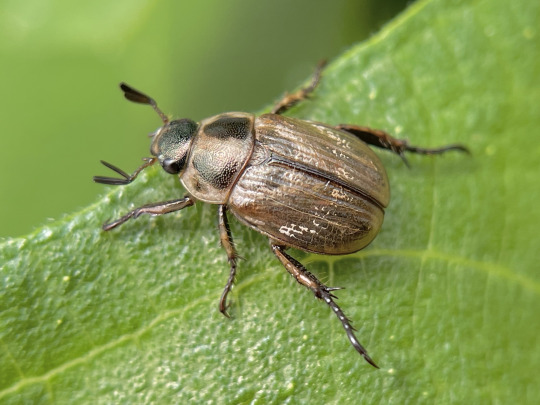
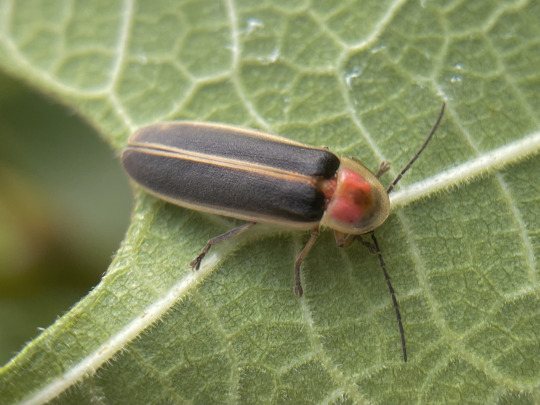
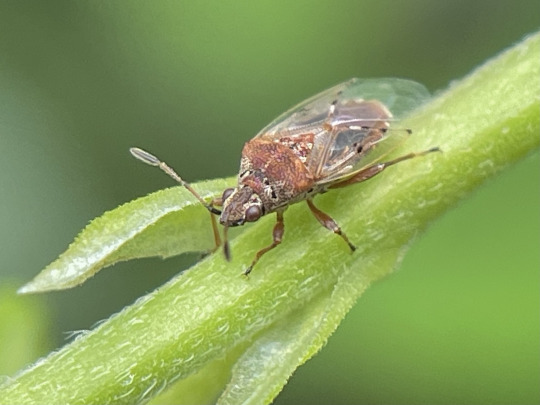
a few spare hemipterans: a Kleidocerys resedae that blew in on a wind, and below, the mulberry whitefly Tetraleurodes mori feeds on its namesake host. as for Hymenoptera, I saw manny tiny parasitic braconid wasps and various ants attracted to the planthoppers’ honeydew excretions—always worth checking underneath roosting hoppers for things having a drink.

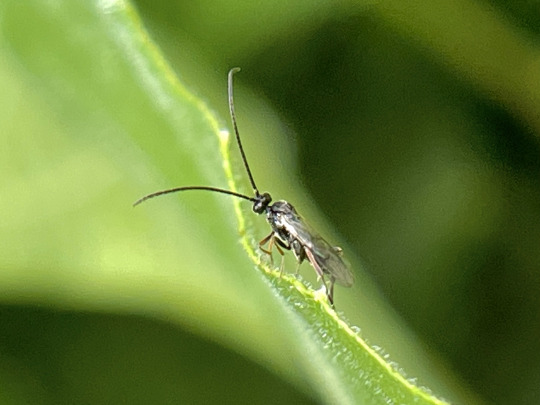



a couple handsome spider boys were scrambling through the fig seeking females, a jumping spider Paraphidippus aurantius and an orbweaver, Mecynogea lemniscata.


and to round it off, a young Conocephalus meadow katydid and a Carolina mantis, Stagmomantis carolina.
there’s 31 species of arthropod in this post, and I probably saw some 45, not all of which stayed for photos. if you walk slowly and look closely, you can see a sizeable chunk of your local biodiversity in under fifteen minutes! of course this will depend on where you live and what time of year it is, but there’s almost always more cool bugs out there than you’d expect, even on just a single plant.
1K notes
·
View notes
Text


Calligrapher flies / genus Toxomerus
18 notes
·
View notes
Photo










Marginated Calligrapher Hoverfly - Toxomerus marginatus
While looking through the blog’s insect orders to decide what new insects need to be added, it was surprising to learn that this tiny Hoverfly hasn’t been introduced. I’ve fast tracked it for today so that it can join its fellow Hoverflies and so that you can discover it. If the name sounds familiar though, it could be because earlier on a close relative was introduced to this blog: the Eastern Calligrapher Hoverfly. Both are members of the Toxomerus genus, and both look a bit similar from a distance. Moreover, both Calligrapher Hoverflies have a close resemblance to the Common Oblique Hoverfly, which itself sits on a different branch of Syrphidae. As I usually say though, detail work is necessary for successfully identifying the insects in your backyard (and location too, never forget about geographic location). Lucky for us, these Flies can be somewhat easily told apart by looking that the top of their thoraxes and the patterns on their abdomen! The Marginated Calligrapher tends to have a yellow plate below the scutellum, rather than matching the scutellum’s color and their scutellum seems to lack fading vertical stripes. Since variability is a factor, the thorax can be a good starting point for identification, but the abdomen* gives us a lot more to work with. I mean, look at the intricate patterns between the Marginated and the Eastern Calligrapher.
While the latter’s look more like arrows, the Marginated Calligrapher has these divided “upside down” trapezoid patterns towards the end of its abdomen with 3 stripes at the front of the abdomen: black, yellow, black. How very intricate! Not only that, but with individual variation from environmental heat or genetic factors, some individuals may emerge from their pupae with a striking orange color similar to some of the individuals here. Stunning! So yes, look for the patterns and the answer should be clear, but there’s something else you should look for. Since patterns can be faded or reduced (also thickened thanks to variation) in these insects, look for a black dot at the tip of the abdomen for the Marginated Calligrapher. The wings may cover it, so have patience when observing. If you do find these insects in your yard, know that they are handy insects to protect plants from Aphid and soft-bodied insect attacks. This Fly’s larvae consume Aphids to grow strong (I wonder if they clash with other predators such as Ladybugs?). The adults are more peaceful however, taking to various flowers for sustenance much like the Bees they resemble. They are quite small, so it gives me a chuckle to see an individual inside a relatively giant-sized rose. I’m glad they frequent those flowers; Aphids like to hide on the underside of our rose leaves in the summer, so potentially having some Fly larvae keeping their numbers in check is reassuring.
*Note: While I describe the patterns for identification, most professionals first look at the margins of abdomen. Look there if you can, by you may need a live specimen or close-ups of the insect to do so.
Pictures were taken on May 24-26 and June 29, 2019 with a Samsung Galaxy S4 and on June 19, 2022 with a Google Pixel 4.
#jonny’s insect catalogue#ontario insect#fly#marginated calligrapher#hoverfly#diptera#insect#toronto#may2019#june2019#2019#june2022#2022#entomology#nature#invertebrates#arthropods#photography#animals
4 notes
·
View notes
Text
did i tell you all about the professor who contacted me for research help in need of atlantoscia floridana specimens????
idk if i ever did!
well i sent them off and the day after he emailed me that they arrived safe and sound i was contacted by an inaturalist user i talk to sometimes about assisting in the understanding of hoverfly genus toxomerus species in florida. i emailed the professor he directed me to and now im just waiting for his vials of alcohol to arrive so i can start collecting specimens to send back for expert analysis
life is cool and im still dragging my feet through college because school sux i just wanna skip right to being a scientist already
5 notes
·
View notes
Photo

day 8 of the insect inktober prompts by @six-legs-and-more - stripes! i did one full body of a calligrapher fly (genus toxomerus) and for lack of energy and motivation, two additional abdomens of other species without the rest of the body lol
these are mostly ink, but unlike my others that have been all ink, i used ebony pencil on the abdomens because they had shiny bits
all three patterns are based off of species ive seen in my yard!
#inktober#inktober2018#stripes#Toxomerus#theres a slight hiccup in the main fly's pattern but its fine#just i forgot to make a line go up but didnt want to leave it flat so i made a line go down#my art
17 notes
·
View notes
Photo




after many disappointing days, i found SO MANY cool bugs in my yard today! invluding the first thyanta perditor ive seen in weeks, but i couldnt get a photo of it.
heres some nice pics of cool bugs that i didnt think were quite good enough photos to put in the drafts/queue
you can see all of these and more on my inaturalist, kuchipatchis (though i saved some photos just for here!)
the first two i have no clue at all what they are. the third is definitely a moth, i think a sun moth of some kind. the final thing is genus toxomerus, species unidentifiable - literally, no one can ID a good portion of floridian toxomerus species.
#bugblr#inaturalist#insects#redid this post because tumblr mobile got a terrible update for posting photos
18 notes
·
View notes
Text
its wild how much of a mystery so many floridian flies are
like toxomerus - you post almost anything other than t. boscii on any ID site and everyone is just like, florida ¯\_(ツ)_/¯
i often talk to someone on inaturalist who has basically consumed every bit of accessible information about that genus but theres still so much mystery
2 notes
·
View notes